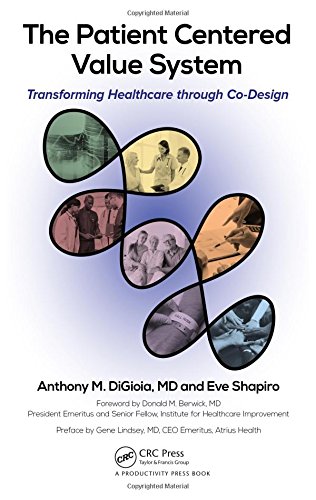The Patient Centered Value System Transforming Healthcare through Co Design 1st Edition by Anthony Digioia, Eve Shapiro 1351677646 9781351677646
$50.00 Original price was: $50.00.$25.00Current price is: $25.00.
The Patient Centered Value System: Transforming Healthcare through Co-Design 1st Edition by Anthony M. Digioia, Eve Shapiro – Ebook PDF Instant Download/DeliveryISBN: 1351677646, 9781351677646
Full download The Patient Centered Value System: Transforming Healthcare through Co-Design 1st Edition after payment.

Product details:
ISBN-10 : 1351677646
ISBN-13 : 9781351677646
Author: Anthony M. Digioia, Eve Shapiro
Imagine: You are a hospital Chief Executive Officer, Chief Financial Officer, medical or nursing director, patient safety specialist, quality improvement professional, or a doctor or nurse on the front lines of patient care. Every day you’re aware that patients and families should be more engaged in their care so they would fare better both in the hospital and after discharge; their care could be safer and more seamlessly coordinated; patients should be ready for discharge sooner and readmitted less often; your bottom line stronger; your staff more fulfilled. You enter into new payment models such as bundling with an uneasy awareness that your organization is at risk because you don’t know what the care you deliver actually costs. Like most healthcare leaders, you are also still searching for a way to deliver care that will help you to achieve the Triple Aim: care that leads to improved clinical outcomes, better patient and family care experiences, and reduced costs. Sound familiar? If so, then it’s time to read The Patient Centered Value System: Transforming Healthcare through Co-Design. This book explains how to introduce the Patient Centered Value System in your organization to go from the current state to the ideal. The Patient Centered Value System is a three-part approach to co-designing improvements in healthcare delivery—collaborating with patients, families, and frontline providers to design the ideal state of care after listening to their wants and needs. Central to the Patient Centered Value System is seeing every care experience through the eyes of patients and families. The Patient Centered Value System is a process and performance improvement technique that consists of 1) Shadowing, 2) the Patient and Family Centered Care Methodology, and 3) Time-Driven Activity-Based Costing. Shadowing is the essential tool in the Patient Centered Value System that helps you to see every care experience from the point of view of patients and families and enables you to calculate the true costs of healthcare over the full cycle of care. Fundamental to the Patient Centered Value System is the building of teams to take you from the currents state of care delivery to the ideal. Healthcare transformation depends not on individual providers working to fix broken systems, but on teams of providers working together while breaking down silos. The results of using the Patient Centered Value System are patients and families who are actively engaged in their care, which also improves their outcomes; providers who see the care experience from the patient’s and family’s point of view and co-design care delivery as a result; the tight integration of clinical and financial performance; and the realization of the Triple Aim.
The Patient Centered Value System: Transforming Healthcare through Co-Design 1st Table of contents:
1: The Patient Centered Value System in Action: A Story
Prologue: The Epiphany
1: How to Introduce the Patient Centered Value System in Your Organization
2: Choose Your Champions: Establish the Care Experience Guiding Council
References
3: Shadow Patients and Families to Co-Design the Care Experience
4: Develop Your Care Experience Working Group
5: Create a Shared Vision by Writing the Story of the Ideal Care Experience
6: Close the Gaps between the Current State and the Ideal
7: The Patient Centered Value System: Fact, Not Fiction
2: Determine and Drive Down the True Cost of Care Delivery and Achieve the Triple Aim
8: Determine the True Cost of Care Using Shadowing and Time-Driven Activity-Based Costing
Origins of the Patient Centered Value System
What Is Time-Driven Activity-Based Costing in the Context of the Patient Centered Value System?
Benefits of Time-Driven Activity-Based Costing
Time-Driven Activity-Based Costing Plus Shadowing: A User’ s Manual
Step 1: Shadow the Care Segment(s)
Time Detail for Personnel, Space, and Activities
Photo Option for Consumables and Equipment
Step 2: Develop Time-Driven Activity-Based Costing Process Maps
Step 3: Calculate Costs in Four Buckets of Resources— Personnel, Space, Equipment, and Consumabl
Personnel
Consumables
Space
Equipment
Calculate the Actual Cost of Each Care Segment and the Full Cycle of Care
The Patient Centered Value System: Identify Cost Drivers to Begin Improvements
Cost Drivers
Implement the Patient Centered Value System
The Need for the Patient Centered Value System in Today’ s Healthcare Environment
References
3: The Patient Centered Value System: Theory and Practice
9: The Science behind the Patient Centered Value System: Built on the Shoulders of Giants
“ Borrowing Brilliance”
Shadowing Patients and Families
Shadowing to Determine Actual (True) Costs
Storytelling and Storydoing
High-Performance Care Teams
Overcoming Expected Hurdles
Conclusion
References
10: Patient Centered Value System + Lean or Other Process Improvement Approaches = Rapid
Similarities between the Patient Centered Value System and Other Process Improvement Approaches
Differences between the Patient Centered Value System and Lean or Similar Process Improvement Approa
Shadowing
Performance Improvement
Integrating the Patient Centered Value System with Lean and Similar Process Improvement Approaches
Conclusion
References
11: The Patient Centered Value System in Practice
Patient Partnerships = Engagement = Better Outcomes
The Problem
The Real-World Solution
Eliminating Waste and Creating Efficiencies While Improving Clinical Outcomes
The Problem
The Real-World Solution
Reducing Readmissions
The Problem
The Real-World Solution
Reducing Staff Turnover
The Problem
The Real-World Solution
Reducing the Cost of Care
The Problem
The Real-World Solution
Conclusion
References
Glossary
People also search for The Patient Centered Value System: Transforming Healthcare through Co-Design 1st:
the values and value of patient-centered care
the patient centered medical home model
the patient-centered medical home
the patient-centered approach to nursing theory
a patient centered approach
Tags: The Patient, Value System, Transforming Healthcare, Co Design, Anthony Digioia, Eve Shapiro
You may also like…
Business & Economics - Management & Leadership
Education Studies & Teaching - School Education & Teaching
Transforming the Curriculum Through the Arts 2nd Edition Robyn Gibson
Arts - Business of Art
Business & Economics
Computers - Applications & Software












